A genie in a bottle? A wishing well? Or an all-knowing crystal ball?
That’s how far we’d go to help you double down on your sales targets in 2024. Unfortunately, I haven’t found those yet, but I have the next best thing for your sales teams.
The top 16 sales strategies from sales leaders and experts to help you overachieve your quotas in 2024!
What is a Sales Strategy?
A sales strategy is a plan or unique way in which a business can improve the sales of its products and services. The aim is to generate more sales with strategies that work at different stages of the company’s growth. In line with that, figuring out the most effective sales strategy is not an easy feat.
To start off, you should watch our webinar, Secrets to Sales Success in 2024, where Amit Sharma, the CEO of Dishah Consulting, shared the best sales management strategies for the coming year.
The sales strategy depends on a lot of factors—the product/service, its price, the buyer persona, and most importantly, your business’ sales methodology.
Based on your team’s strengths and your business’ vision, you can opt for an inbound or outbound sales strategy. Here’s how you can decide which sales strategy your team needs to focus on.
Inbound vs. Outbound Sales Strategy
| Inbound sales strategy | Outbound sales strategy | |
| Definition | Businesses use an inbound sales strategy to attract organic leads into the sales pipeline. | An outbound sales strategy requires salespeople to reach out and engage with potential customers actively. |
| Focuses on | Converting interested and marketing qualified leads into customers. | Creating an ideal customer profile (ICP), building a relationship with them, and generating interest in a product. |
| Lead channels | Website, Landing pages, free trial offers, and marketing activities such as emails and webinars. | LinkedIn outreach, cold emails, cold calls, and offline visits to scope out potential opportunities. |
Choosing between inbound and outbound can be a tough call. But if you’re wondering what’s the most effective approach, the answer is both. Agreed that outbound and inbound have different pros to support their cause, but with appropriate resources and workforce, businesses can strike a balance between these two approaches.
It’s also a sure-shot way to integrate sales and marketing teams for the highest ROI.
The leads may be generated via an inbound or outbound approach, but closures and other sales-related activities still prove challenging for over 66% of salespeople who attended our webinar. Let’s dive right into the steps to build an effective sales strategy.
PS, don’t forget to check out the 16 most-actionable sales strategies at the end of this article.
3 Steps to Plan an Effective Sales Strategy
Whether you aim to start meeting your sales quotas, increase your sales revenue, or decrease churn, you first need to review and tweak your sales strategy. Here’s how you do that.
1. Analyze goal setting
“When 10%–20% of salespeople miss goals, the problem might be the salespeople. But when most salespeople miss, the problem is their goals.”
Andris A. Zoltners, Harvard Business Review
Goal setting can be challenging for sales managers who create targets and also help their teams meet them. Usually, the goals are set in a top-down approach where the CEOs and top management set sales goals based on previous performance.
This approach generally aims to grow sales teams faster, but it does the opposite. Unrealistic expectations and targets set too high often lead to a lack of motivation and rapid employee attrition (around 35%, much higher than any other business team).
Amit prefers the SMART strategy, instead of the top-down approach, to set measurable, time-bound goals.
1. Specific:
A high target shouldn’t be your priority while setting goals. Managers need to focus on identifying particular challenges in their sales cycle stages. Every customer-forward sales stage is an opportunity to identify these challenges at a granular level.
For example, an expensive product or service generally has long sales cycles. So, the goal for your sales team shouldn’t be to double the sales in the quarter. Instead, the team can focus on shortening the sales cycle by half.
“The whole idea is to go specific and focus on one problem every quarter. It’ll add a lot of momentum to your sales process.”
Amit Sharma, CEO, Dishah Consulting
2. Measurable:
“In most cases, sales goals are communicated to the teams, but they’re not broken down into daily activities. The sales team continues to carry out the same activities as they did a year ago, but they’re chasing a higher goal this time. The gap is quite clear; you can’t achieve different goals with the same activities.”
Amit Sharma, CEO, Dishah Consulting
While setting goals, it’s crucial to ensure that your team’s progress toward meeting them can be measured. Amit advises sales teams to implement the OKR formula, where Objectives are broken down into Key Results. Google also adopted this formula in 1996 when their team had just 60-100 employees. Implementing the OKR method helped them grow to where they are today.
Each precise KPI should be closely aligned with your sales objective. For example, if your objective is higher conversions, a key result would be the number of calls each salesperson makes or the number of emails they send. These daily targets can be made visible to ensure that your team knows what to work on.
3. Attainable:
Sales targets are always challenging, but they must also be attainable. A manager must understand his team and what motivates them to set achievable targets. The motivator may be additional earned leaves, incentives, or even a promotion.
“Spend more time with people rather than reports so that you can listen to people and ask them a lot of questions to identify their personal motivations.”
Amit Sharma, CEO, Dishah Consulting
Along with motivation, managers also need to keep the team’s skillset into account while setting goals.
“To identify the skillsets your team needs to be trained on, you can list each stage in the sales process along with the conversion rates at that stage. Your target skillset is linked to the stage with the lowest conversion rate.”
Amit Sharma, CEO, Dishah Consulting
4. Realistic:
An unplanned and unrealistic target can completely throw your sales and marketing teams off their course. They might not have the right resources, skillsets, or personnel to meet targets. A couple of ways to set a realistic target are:
- Take the month-month growth percentages into account while setting their targets, instead of setting a high annual goal.
- Sales quotas can be set by considering the previous year or quarter’s achievements while forecasting a higher yet rational target.
- Involve the salespeople in the process while setting sales goals since they can estimate achievable growth accurately. They can also voice their concerns and requirements for any additional resources.
The definition of a ‘realistic goal’ also depends on the kind of product, the selling price, and the sales cycle length. But in most cases, the important factors in determining the goals for sales and marketing teams are:
- Number of inquiries
- Inquiries to demo ratios
- Resources required to meet the targets
5. Tools and training:
Even if everything’s in place, the lack of the right sales tool can hinder your team from meeting their targets. Before deciding which tool to implement, you can divide your sales activities into productive and non-productive activities.
Productive tasks—sales calls, follow up emails, product demonstrations, etc.—directly impact conversions. Whereas unproductive tasks—generating reports, updating the CRM, etc.—are important but don’t impact sales conversions directly.
Unproductive activities take up 65% of the sales representative’s time. And from a LeadSquared poll during the webinar, our audience shared that sales productivity is the most accurate measure of sales success.
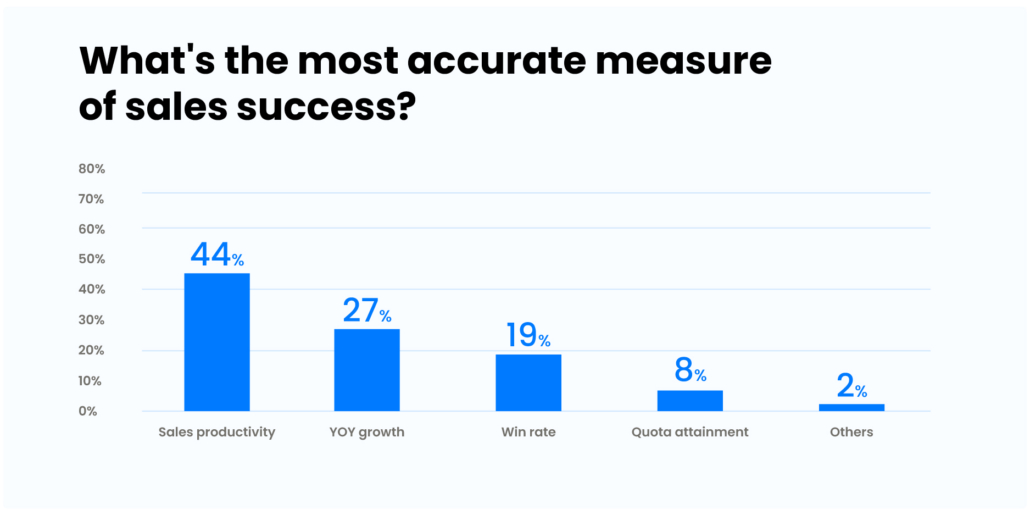
So, how can businesses ensure that sales productivity hits an all-time high without letting go of unproductive tasks? The solution here is the AD model.
AD = Automate or Delegate.
Implementing automation or delegating non-essential tasks instantly boost sales productivity as it allows salespeople to focus on the most productive tasks.
Automation: A comprehensive and extensive sales tool, such as LeadSquared CRM, helps teams automate reporting, dialing, nurturing, lead distribution, lead qualification, and more. With automation, hours of work is carried out with just a few clicks in under 5 minutes. To know how a CRM can help your sales team, you should book a consultation with our CRM experts today!
Delegation: Transfer a few sales-related tasks to other teams, such as marketing for lead generation or presales for lead qualification.
Coming to the training aspect of sales strategy, Amit recommends that sales managers organize customized training sessions for their team based on their skill sets and motivators.
“Business leaders can help customize training sessions by creating a chart with each team member’s strengths and weaknesses. This chart helps the training company provide highly-personalized, performance-driven training.”
Amit Sharma, CEO, Dishah Consulting
2. Focus on building a healthy sales culture
A healthy sales culture keeps the team motivated and decreases employee attrition in the sales team. The managers need to give their teams a bigger purpose, such as becoming the best team in the company.
Backed with this purpose, your sales team will develop innovations and ideas to perform better. A buddy program is another way to boost a healthy environment. Pair a high-performer with a new sales member so that they can help their buddy out.
Lastly, a lack of motivation in sales is also closely linked to the fear of non-performance. Managers must instil confidence in their teams with a skill vs. will method. Here, the skill-related challenges are the manager’s job where they help their sales team, but the will or motivation factor is the sales representative’s responsibility.
“Managers need to recognize and encourage initiatives such as coming up with new ideas or helping their team out. These initiatives should also be evaluated while discussing promotions and incentives.”
Amit Sharma, CEO, Dishah Consulting
3. Communicate feedback for faster results
A sales team that doesn’t understand each other or can’t share feedback internally often struggles to do the same with their customers. Feedback is always great, but the way it is delivered can make or break a sales team’s trust in their manager.
According to 42% of salespeople, enabling a two-way communication channel is also one of the best ways a manager can support their sales team.
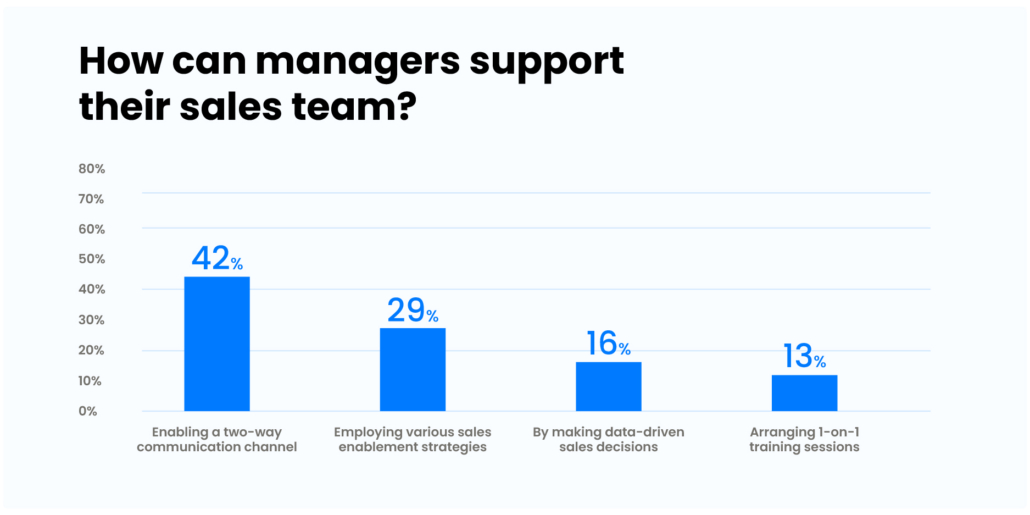
A few best practices to deliver feedback effectively are:
- Set clear expectations from the start. Whether you’re assigning a task or at the start of the quarter, the salesperson should know what is expected of them.
- Don’t wait till appraisals share your feedback. Utilize feedback as a proactive and preventative mechanism instead of a post-disaster activity. With multiple deals running parallelly in the pipeline, it’s only wise to make your reviews and feedback sessions frequent so your team can improve faster.
- Identify erratic behaviors early on. It might be due to a lack of motivation or something you’re completely unaware of as a manager. Ask your sales teams questions about what is affecting their performance and provide them with a behavior improvement plan to rectify their shortcomings.
“Sales leaders need to get in touch with their teams to understand their problems. I advise them to praise their teams in public but always criticize them privately to keep the morale high. While criticizing them, the conversation should always move towards building a well-defined improvement plan.”
Amit Sharma, CEO, Dishah Consulting
Now, lets get to the most exciting bit that you’ve been waiting for. We did the work for you and talked to three sales experts to bring you 20+ years of experience condensed into a list of the 16 most actionable sales strategies for 2024. But first, meet our experts:
1. Murali Krishna, Vice President – Sales, LeadSquared
2. Piyush Sharma, Manager – Business Development & GTM, CloudSEK
3. Amit Sharma, CEO, Dishah Consulting
16 Examples of Winning Sales Strategy that Drive Conversions
After experimenting with a lot of sales strategies at LeadSquared, and talking to sales experts, we’ve come up with a comprehensive list of 16 sales strategies that’ll transform your sales outcomes.
16 sales strategy examples for 2024:
- Improve the first point of sales contact
- Don’t stick to a specific sales process
- Focus on generating your own leads
- Proactively review sales outcomes
- When something breaks, go back to the basics
- Align your sales and marketing teams
- Inform your prospects instead of convincing them
- Learn to prioritize sales opportunities
- Don’t forget to target niche markets
- Shorten your TAT with automation
- Make the most out of your CRM
- Improve hiring and onboarding for your sales team
- Introduce and manage multiple touchpoints
- Close deals with confidence
- Enable self-service options for customers
- Build and update sales enablement resources
Now, let’s get into the specifics and the actionable tips our experts have for you!
1. Improve the first point of sales contact
Whether it’s an email, a cold call, or a pre-sales call to book a meeting, the first impression sticks, and unfortunately, it’s tough to recover from a bad interaction. Each customer-facing interaction can be improved if the salesperson understands the product in-depth.
Statements like “I will have to get back to you on that”, “I’m not sure”, and “My colleague may know better” aren’t appreciated and will make the potential customer lose interest in your offering.
So, even your BDRs and SDRs should understand the specifics of the product, the market scenario, and competitor analysis before they get on a call with the client.
2. Don’t stick to a specific sales process
Hear me out! The sales process is considered the holy grail to convert leads but following it blindly doesn’t guarantee a 100% conversion rate. There’s a lot of unexplored scope to achieve better results by just experimenting with your sales process.
“Look beyond the step-wise basics of the sales process to evaluate what’s working and what isn’t. Salespeople who are self-learners perform a lot better than process followers. I advise my team to be curious about the solution we offer and understand how it helps our buyers sell better.”
Piyush Sharma, Manager – Business Development & GTM, CloudSEK
Salespeople should also look around and understand what their peers are doing differently and their managers can help them scale up the high ROI activities for the entire team. For example, Piyush realized that one of his sales representatives was going beyond the script to understand the customer’s organizational hierarchy and internal process. These questions helped them get in touch with the right people and shorten the sales cycle.
3. Focus on generating your own leads
As we discussed, a balance between inbound and outbound lead generation is key for any business. But the specific channels vary across industries. For example, outbound strategies aren’t the best way to sell a product with a high-ticket size but deliver results for services that aren’t too expensive.
A few ways in which salespeople can generate their own leads are:
- Focussing on referrals: Referrals are a low-cost lead generation source to increase the value of your pipeline. A referred customer is four times more likely to make a purchase and has a 37% higher customer retention rate.
- Targeted outreach: Personalized and well-segmented approach over email and LinkedIn can help salespeople generate hot leads for quick conversions. With the right connections on social media, salespeople can implement ABM (Account Based Marketing) initiatives to land on qualified leads.
- Utilize social media platforms: High-performing sales folks leverage their connections to meet their targets. Thought leadership and social selling are two skills that salespeople can pick up to boost their conversions. [Here’s a quick guide to get you started on social selling: The Ultimate Guide to Social Selling + Expert-Tips by Top BDRs]
You can also rely on the leads that your marketing teams generate, but when salespeople get in touch with qualified ICPs, the sales cycle becomes shorter, and before you know it you’re just a few deals away from exceeding your targets.
4. Proactively review sales outcomes
Monthly and quarterly meetings don’t work for fast-growing teams. Sales leaders must have all hands on deck weekly to increase the win rates. This means generating weekly reports, setting weekly targets, and reviewing them.
For example, if you notice that you’re losing your customers to competitors in a weekly meeting. You can act on it immediately to take measures that prevent churn.
“Weekly reviews help businesses get control over their sales activities and experiment new strategies much quicker. It decreases your reaction time and improves pipeline forecasting as well.”
Murali Vice President – Sales, LeadSquared
5. When something breaks, go back to the basics
When your sales performance seems shaky it’s time to anchor your boat by reviewing the core of your sales process. Here are the four Ps of your sales process that you need to get to the bottom of to find any leaks:
- Prospect: Review your ICP (Ideal customer profile) based on previous successful deals. For B2Cs, an ICP may be defined by gender, age, geographical location, income, etc. Whereas for B2Bs, it may be the designation of the decision maker or the industry you’re targeting.
- Product: Do you understand every feature and use case of your product/service? If not, get to work till you know your product in depth.
- Proposal: Does your proposal cater to the customer’s needs, and are you adding any value to their business? You can also prepare a list of customer pain points your product solves and use it as a resource to customize proposals. It’s also an excellent time to review pricing and discounts.
- Pitch: Listen to the recordings of your previous sales pitches to see what worked and what didn’t. As a salesperson, you can also ask your managers or peers to share their feedback on your pitch.
6. Align your sales and marketing teams
The quality of leads matter just as much as the quantity of leads generated by the marketing team. Salespeople have a much better idea of the right ICPs and buying intention, whereas the marketing team understands how these leads can be attracted and nurtured till conversions.
The power-packed sales and marketing duo can help you beat your targets easily. You also need to implement a feedback mechanism between these two teams to decrease the scope of any miscommunications.
7. Inform your prospects instead of convincing them
“No one likes being sold to, not even salespeople themselves. Try to cater to your prospect’s interests before reading out your entire pitch to them. This challenge arises during demos when salespeople forget that the customer is looking for a solution and not a list of random features that they don’t understand.”
Piyush Sharma, Manager – Business Development & GTM, CloudSEK
38% of salespeople wish to focus on consultative selling in 2023. And our experts believe it’s high time for salespeople to start solving their customers’ challenges in the product demo itself.
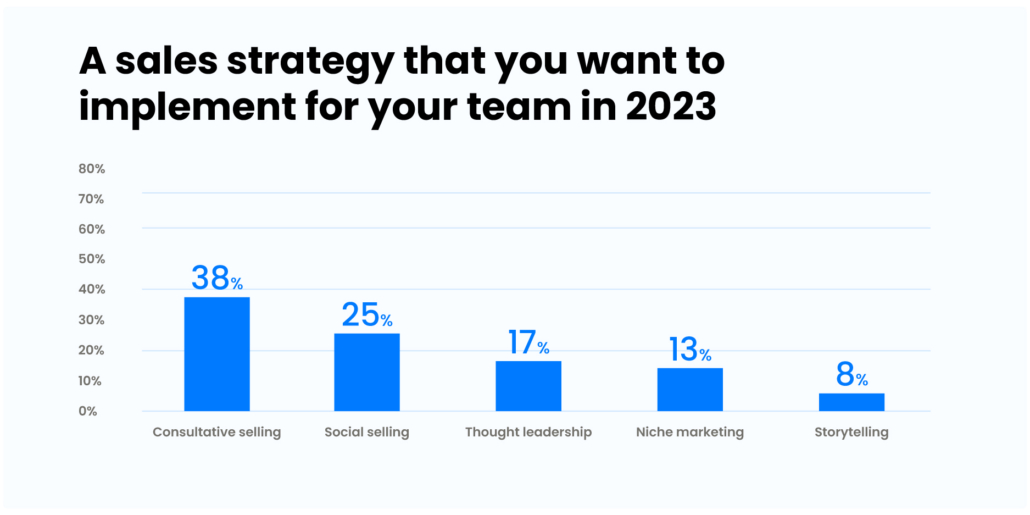
Salespeople can customize product demos to highlight just 1-2 features of the product or service that solve the user’s challenges. For example, an EdTech that coaches students for competitive exams can focus on how impactful their mock tests are for students.
The critical skills salespeople can develop for consultative selling are active listening and attention to detail. These skills help them identify the challenge and take a deep dive into solving it.
[Also read: Consultative Selling: a Key to Win Big Accounts [with Real Life Examples]]
8. Learn to prioritize sales opportunities
“Being able to identify the customer’s need is one of the most important sales functions. They must differentiate whether the situation is a burning point for the customer or they’re just exploring a few ways to improve their business.”
Murali Krishna, Vice President – Sales, LeadSquared.
Along with skill, salespeople can utilize data using lead scoring functions that most CRMs offer to prioritize hot leads over cold ones. It’s beneficial because it automatically structures sales activities for faster results. You might just meet your target by focusing on ten hot leads instead of sifting through hundreds of cold leads aimlessly.
9. Don’t forget to target niche markets
A targeted approach is the most consistent theme across various sales strategies. It’s extremely relevant for teams with multiple product offerings catering to different buyer segments.
If you run such a business, you have more than one ICPs to cater to, which means that your sales team also needs different kinds of training, pitches, and relevant resources to share with the customers. Throwing wider nets to close deals may not be the best option here.
You can try switching to a vertical approach instead, where sales representatives develop niche skills to focus on just one segment of buyers. The training and sales process differs for each vertical, and it might seem like a lot of work initially. Once you have refined your business for the vertical segments, scaling up will eventually seem a lot easier.
You also need to segregate and distribute your leads to the different segments of sales representatives based on their knowledge of the industry and specific skill sets. A CRM can help you with automated lead distribution based on different kinds of lead tags and segmentation.
10. Shorten your TAT with automation
Turnaround time (TAT) is a super important KPI for B2C businesses because you don’t want your competitors to swoop in and steal your customers. To win a deal, you need to be the first one to contact them with the most relevant solution.
Ideally, your TAT should be under ten minutes, and at most, the first interaction should happen the same day. Manual lead distribution, dialing, and noting down customer information add hours to your TAT for no reason. Here’s how intelligent CRM technology helps businesses decrease their TAT:
1. Automate sales workflows
2. Track and monitor TAT as one of the sales performance KPIs
3. Enable alerts and reminders as escalation options for tasks.
11. Make the most out of your CRM
Even though 91% of businesses with more than 10 employees use a CRM, it’s usually underutilized when sales leaders don’t realize its potential. At its basic level, a CRM helps you track sales data, measure sales performance, forecast deals, manage pipelines and completely automate workflows.
But that’s just the bare minimum that you get from a CRM. To use it effectively, you need to explore each data source and report that your CRM offers. It helps you track the lead journey and drop-off points across each stage in the sales cycle. Salespeople can also use the call notes to improve their pitches.
“The call notes in a CRM can help sales teams uncover many details, such as the points of objection, the sales cycle stages with the highest and lowest conversion rates, and the customer’s initial response to your product. Call notes along with the feature to monitor sales teams and the best features of a CRM, which are ironically also the most underutilized.”
Piyush Sharma, Manager – Business Development & GTM, CloudSEK
12. Improve hiring and onboarding for your sales team
Sales is competitive. But this competition extends out to hiring the best talent too. When you lose out on a star performer, the deals they were working on tend to have a higher chance of churn.
The first step is to identify and hire the right talent. And the second step is to onboard and train them to avoid underperformance. The initial onboarding process is crucial to sales success. The sales team is trained on the sales process and the skills required to perform well.
Businesses can create a well-defined 30-60-90-day onboarding plan for their sales teams, and implementing it will improve sales revenue. Here’s a checklist to ensure that your new joiners in the sales team are ready to face any challenges.
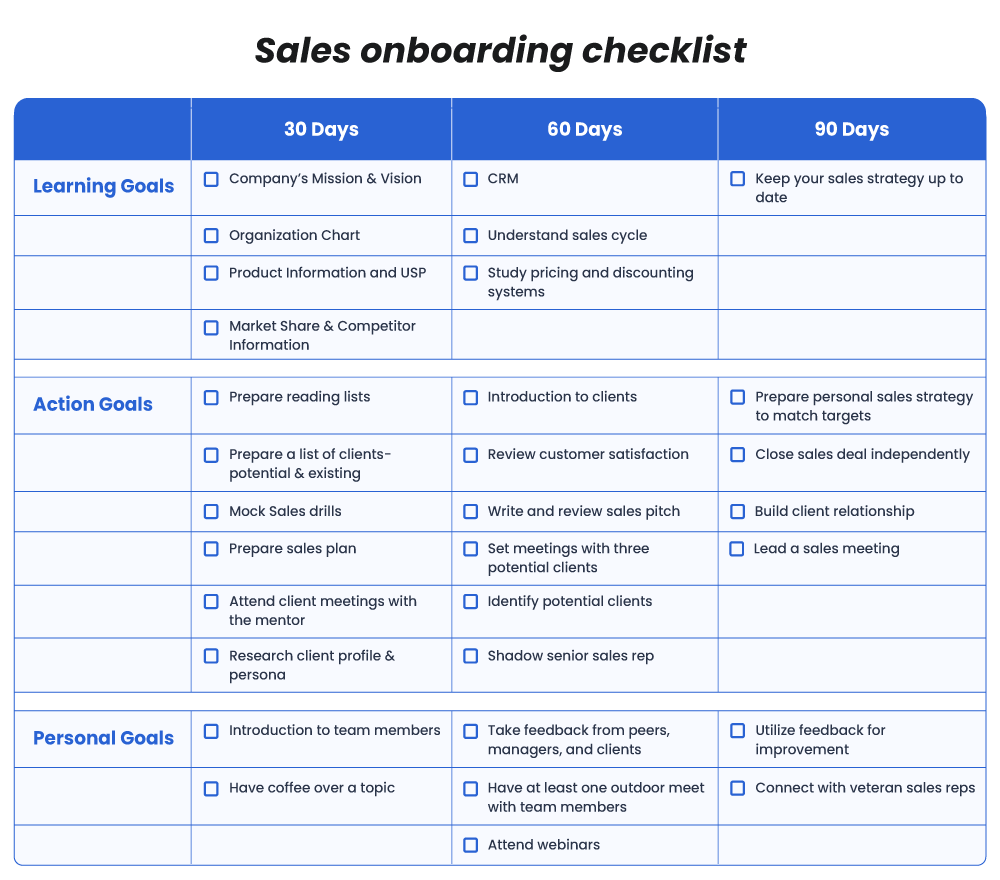
You can also download this editable pdf checklist to share with your team.
13. Introduce and manage multiple touchpoints
A LeadSquared study found that it takes 5-10 touchpoints to complete a sale. But some salespeople give up after a few attempts. These touchpoints span various online and offline channels such as in-person meetings, follow-up emails, sharing resources, and much more.
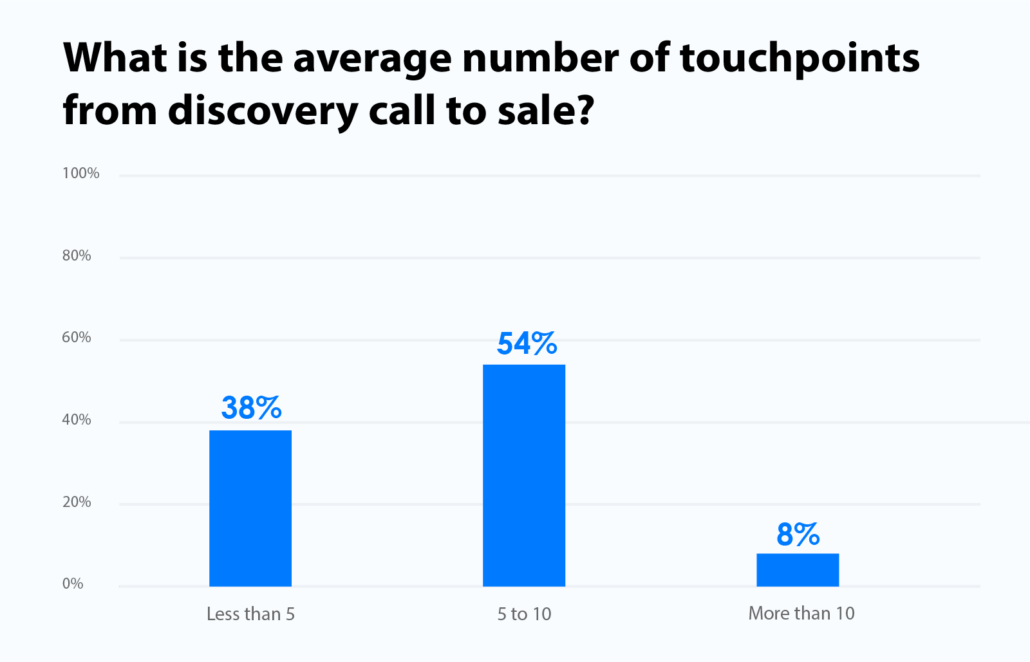
Salespeople struggle to manage multiple deals simultaneously without losing the context of what was discussed at the previous touchpoint. Businesses can try to bridge the gaps between the touchpoints to improve the customer journey and prioritize the most important contact points.
Unfortunately, each touchpoint adds another task to your salesperson’s overflowing list. Using a sales CRM, helps salespeople track conversations and automate a few tasks at the same time. What’s better than getting the job done without overworking your sales staff?
14. Close deals with confidence
35% of salespeople find closures to be the toughest stage in their sales process. Closing a deal needs a lot of skill and technique, which you can train your sales teams on. At the same time, the process can be optimized by creating templates for closures or setting standardized closure statements.
Closure statements can either be a discounted offer, such as “I should let you know that we have a special [X%] discount available for those who signup within this week. I wouldn’t want you missing out” or a question like “Considering all your requirements, I think these two products would work best for you. Would you like to go with [X] or [Y]?”
You don’t have to look any further; check out closing techniques and scripts that have worked for our team LeadSquared: 15 Smart Sales Closing Techniques [Scripts and Examples]
15. Enable self-service options for customers
As the buying trends shift, customers are now looking for self-service options to make a purchase. This redefines the term ‘sales’ since businesses need to investigate alternative selling options, such as informative landing pages and chatbots, that allow users to explore and understand the product even before they talk to a salesperson.
For example, for education or edtech businesses, a chatbot can guide the students through the course plan, curriculum, and other details. Using a student portal also allows them to fill in their information based on their convenience and then complete the payment without any external assistance.
While enabling a self-service option, businesses invest a few resources into setting up automated workflows that make it convenient for the user. But eventually, the self-service source becomes a high ROI machine that generates easy-to-convert leads.
16. Build and update sales enablement resources
Helping your sales team goes beyond just training them or sharing feedback. You also need to enable them with the tools and resources to sell better.
“A list of FAQs, checklist of topics to cover in a pitch, battle cards against competitors—all prove to be cheat sheets that can be displayed on the screen for salespeople while on a call. These are just a few ways to make your team feel better equipped to deal with objections.”
Murali Krishna, Vice President – Sales, LeadSquared
The sales team can collaborate with marketing efforts to work on resources such as case studies, eBooks, and decks that help them nurture their prospects effectively. These resources help the sales team decrease the length of the sales cycle and maybe even introduce opportunities to upsell their offerings.
And that brings us to the end of this article. While these are all the tips we have for you, this list isn’t exhaustive because sales strategy isn’t the same for everyone. You might even adopt a different set of strategies next quarter itself.
The thrill of it lies in experimentation. You just need to identify where your sales process or team may be lacking, and that’s where I can help you.
LeadSquared helps sales leaders monitor and track sales performance, pipelines, and customer journeys. At the same time, it automates workflows and tasks for your team. That’s all the ammunition you need to build an explosive sales strategy!
Get started by booking a consultation with our CRM experts today.
FAQs
Instead of relying on Excel sheets, businesses can implement a CRM to improve reporting and automate sales tasks. You can even revive cold leads with email automation or send invoices to customers—the possibilities are endless. The reports on a CRM tool can help you understand the sales process and your team’s skillset, which gives you an edge over your competitors.
The following sales performance KPIs shape sales strategies:
1. Sales conversions
2. Length of the sales cycle
3. Sales value
4. Deal profitability
5. Customer lifetime value
Defining the sales target is a strategy that works well for newly launched products, especially for small businesses. The preliminary target should be to generate interest from prospects and communicate the offerings. The teams can meet your customers and share relevant information to build the pipeline. By doing so, you’ll have a few people who are interested and excited to try out your product.
To strategize a sales plan, you need to work with and for your sales team. Here are three steps to get started:
1. Re-evaluate your goals: Are the targets too high? Have you accounted for market fluctuations? Sales can get demotivating if your targets are unrealistic.
2. Build a sales-friendly culture: Managers need to enable and motivate their team to sell better, and it’s easier if your sales strategy accounts for it. This includes sales incentives, training sessions, and building resources for your team.
3. Collect feedback from your sales team: You can’t strategize a new sales plan without knowing what was wrong with the previous one. Always collect insights and perspectives from your team before making any changes. The success of your sales strategy majorly depends on this step.







